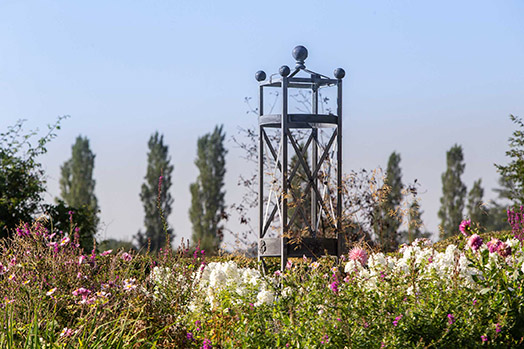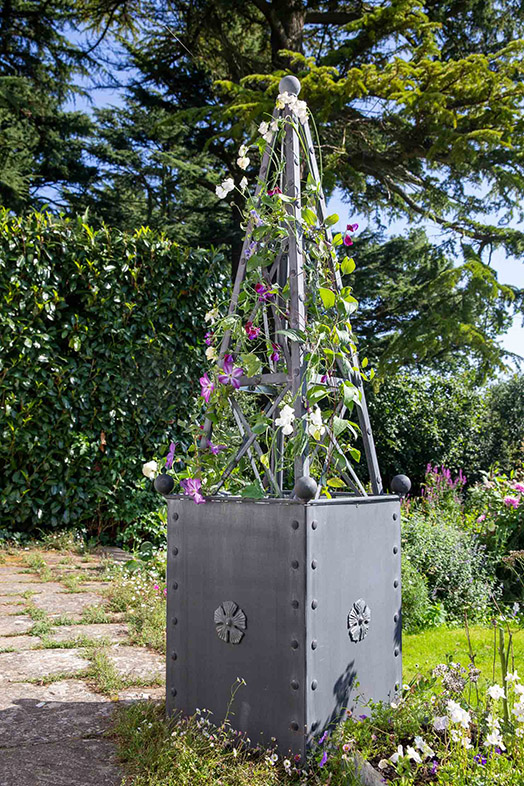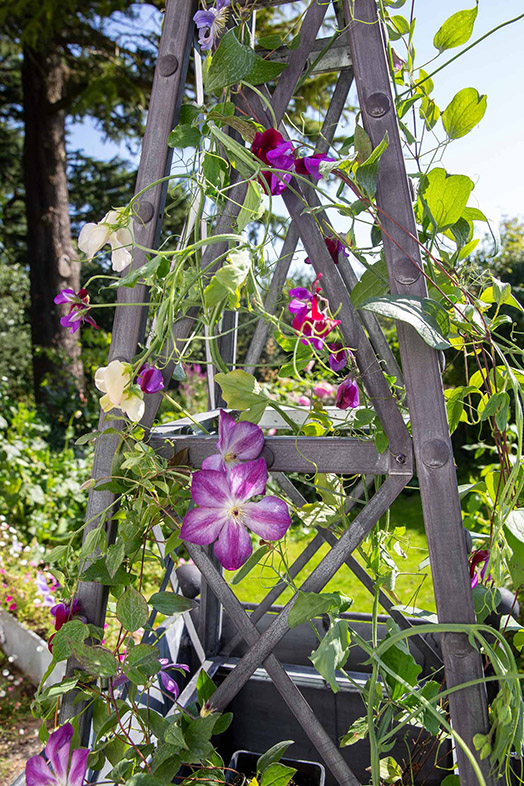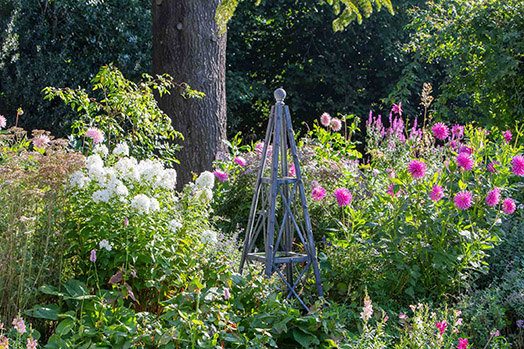
Have you ever seen an obelisk in a garden before? Obelisks are tall, four-sided structures that can be used to great effect when landscaping. But did you know that certain plants grow better on obelisks than others? In this blog post, we will explore the types of plants that thrive on obelisks and how they can add beauty and structure to your outdoor space. We’ll also discuss some tips for selecting the right type of plant for your specific needs. By the end, you should have a clear idea of which plants grow best on an obelisk and why it might be worth investing in one for your own garden!
What is the purpose of an obelisk in the garden?
An obelisk is not only an aesthetically pleasing addition to any garden, but it also serves a practical purpose. It is commonly used as a garden trellis for climbing plants such as roses, runner beans or clematis or used alone as a dramatic focal point in a garden to draw the eye upwards, making the space feel larger. Whether for function or decoration, an obelisk adds a lovely feature to your garden.

Make Sure You Choose a Weatherproof Obelisk for Your Garden
When it comes to adding a decorative and functional element to your garden, an obelisk can be a great option. However, it’s important to choose one that is weatherproof to ensure it lasts through rain, wind, and other weather conditions. An Arthur Jack obelisk is manufactured in England with thick galvanised steel that can withstand the elements and will last longer than wooden garden obelisks. An Arthur Jack obelisk features cross bracing for both strength and for plants to attach themselves to without the need for wire. Not only will an Arthur Jack obelisk stand the test of time, it will also keep your plants and climbing vines supported and looking beautiful in your garden year round. So if you’re looking to add an obelisk to your garden, be sure to choose an Arthur Jack obelisk that can weather any storm.
Consider the Ideal Conditions for Growing on an Obelisk
When it comes to growing plants on an obelisk, there are a few key conditions that should be considered in order to create the ideal environment for growth. First and foremost, the obelisk should be made of a material that is sturdy enough to support the weight of the plant as it grows, such as the thick galvanised steel of an Arthur Jack obelisk. The surrounding soil should also be nutrient-rich and well drained soil to ensure the plant receives the necessary nutrients and doesn’t become waterlogged. Additionally, the obelisk should be placed in an area that receives ample sunlight, as most plants require at least six hours of direct sunlight daily. By creating these ideal conditions, plants can flourish on an obelisk and create a unique and eye-catching addition to any garden or outdoor space.
Pick Plants That Grow Vertically and Don’t Sprawl Outward Too Much
When it comes to picking plants for your garden, it’s important to consider not just their appearance, but also their growth habits. Plants that sprawl outwards can quickly overtake a space, leaving little room for other flora to thrive. To combat this, consider choosing a climbing plant that grows vertically, rather than horizontally. Climbing roses, for example, can be trained to grow up garden obelisks or a garden trellis without taking up too much ground space. Vining plants, such as runner beans or peas, can also be grown vertically, using the garden obelisk to support their growth. By incorporating these types of plants into your garden, you can grow plants that create a lush, beautiful space without sacrificing functionality or convenience.
Select Climbing Plants That Have Colourful Blooms or Foliage
When it comes to selecting the best climbing plants, there’s nothing quite like those with colourful blooms or foliage. They can add a stunning pop of colour to any outdoor space, from vibrant pinks and purples to bright oranges and yellows. Not only are these plants beautiful to look at, but they also add texture and dimension to your garden trellis. You can choose from a variety of climbing plants such as trumpet vine, climbing roses, clematis, and bougainvillea to find the best climbing plants that match your personal style and taste. Whether you’re looking to spruce up your garden or create a statement piece in your backyard, climbing plants with colourful blooms, dark green leaves and foliage can certainly do the trick.
Plant Vining Vegetables and Flowers to Maximize Your Growing Space
Looking to grow more plants but don’t have enough space? Planting vining vegetables and flowers may be the solution you need. These types of plants grow upward instead of spreading out horizontally, maximizing your growing space. Options like cucumbers, tomatoes, and runner beans in a vegetable garden can produce an abundant harvest while also adding beauty to your garden. Additionally, vining flowers and fragrant blooms such as morning glory or clematis provide a pop of colour and a fragrant aroma. So, whether you have a small balcony or a spacious backyard, vining plants can help you make the most of your gardening space.
Popular vines for obelisks, including sweet peas, morning glories, and clematis
If you’re looking for the best climbing plants to adorn your obelisk, you can’t go wrong with sweet peas, morning glories, and clematis. Sweet peas not only look gorgeous with their delicate blooms, but they also emit a lovely fragrance that will enhance your outdoor space. You can choose from a variety of colours and their growth is vigorous, so they’ll quickly cover your obelisk. Morning glories are another great option, with their heart-shaped leaves and trumpet-shaped flowers that come in an array of colours. They’re also easy to grow from seeds and thrive in sunny locations with full sun. Lastly, clematis is a beautiful flowering vine and an evergreen climber that can climb up to 20 feet tall. Its blooms come in a range of colours, from purple to red to white, and its foliage provides stunning greenery even when it’s not in bloom. Whatever you choose, these popular vines are sure to add a touch of elegance to your obelisk.
What climbers are suitable for an obelisk?
When it comes to climbing plants suitable for an obelisk, there are a variety of options to choose from. Clematis, for example, is a popular choice due to its ability to easily wrap around the structure and create a stunning visual display popular with garden designers. Another climber that works well on an obelisk is the honeysuckle plant, which produces fragrant, colourful flowers and requires minimal maintenance. For a more unique option, consider the star jasmine plant, which features tiny, star-shaped flowers and can create a lovely aroma in your garden.
What are quick growing climbers for an obelisk?
If you’re looking for some quick growing climbers for your obelisk, then there are a few great options to choose from that grow quickly. One popular choice is the sweet pea plant, which not only adds beautiful colour to your obelisk but also fills the air with a fragrant aroma. Another great option is the runner bean plant, which features attractive green foliage and produces edible beans as a bonus. For a more exotic look, you may consider planting the morning glory plant, which produces stunning trumpet-shaped flowers in a range of vibrant colours. Chinese wisteria is a perennial deciduous climber which grows very quickly. Lastly, the clematis plant is an excellent choice for those who want to add some visual interest to their obelisk; with its showy flowers and trailing vines, it’s a real eye-catcher. No matter what option you choose, these climbers are sure to add some vertical interest to your garden in no time.

Can you put an obelisk in a planter?
An obelisk is a stunning architectural feature that captures the attention of anyone who lays eyes on it. It’s a popular decorative piece in gardens, parks, and even cemeteries. The question arises, can you put an obelisk in a planter? The answer is yes, but with a few considerations. Firstly, the planter should be large enough to support the obelisk’s weight, and secondly, make sure the planter is deep enough to hold the obelisk securely. You want to ensure that the obelisk won’t tip over and cause damage. Standing 1.4 metres above ground, our small obelisk is designed as a stand-alone or will snugly fit into our large planter thereby giving additional height to grow clematis, climbing hydrangea and sweet peas etc.

Do you plant inside or outside an obelisk?
Gardening enthusiasts often debate the best way to utilize a garden obelisk. While some prefer to plant directly into the ground around the base of the structure, others opt for planting inside the obelisk itself. The choice ultimately depends on personal preference and the types of plants being used. Planting inside an obelisk can create a striking focal point, especially when using climbing plants that can be trained to grow up and around the structure. Additionally, planting inside an obelisk can help contain plants that have a tendency to spread and take over a garden. However, planting around the base of the obelisk can create a more natural look and allow for a wider variety of plant species to be used. Ultimately, the decision to plant inside or outside the obelisk comes down to the individual gardener’s vision for their space.

An obelisk can be an attractive addition to any garden. It makes a great centerpiece for your plants and also it helps provide support for vines, climbers, and other vegetation. They can make your garden look lovely while being stylish and practical. When adding one to your garden, remember to choose something that is weatherproof and pick foliage or flowering plants that are suitable for the conditions of your garden. Sweet peas, morning glories, clematis and other climbing plants can be grown on obelisks. If you want to enjoy the beauty of nature but with a touch of sophistication, investing in an obelisk to add interest to your garden is definitely worth considering. Have fun choosing a climbing plant that suits the overall theme of your outdoor space – the possibilities are endless.
Take a look at our range of metal garden obelisks in our online shop.


Rose Sutter
Thank you. Do climbing roses do well with an obelisk or do they prefer a trellis?
Arthur Jack
We’ve designed our obelisk uniquely with cross struts to give the support any climber including a rose will require.
The large obelisk would be particularly suitable for a small climbing rose due to it’s 2metre height. Just needing to be tied in as it grows.
The substantial nature of the steel structure would hold even a heavy rose growth in place.